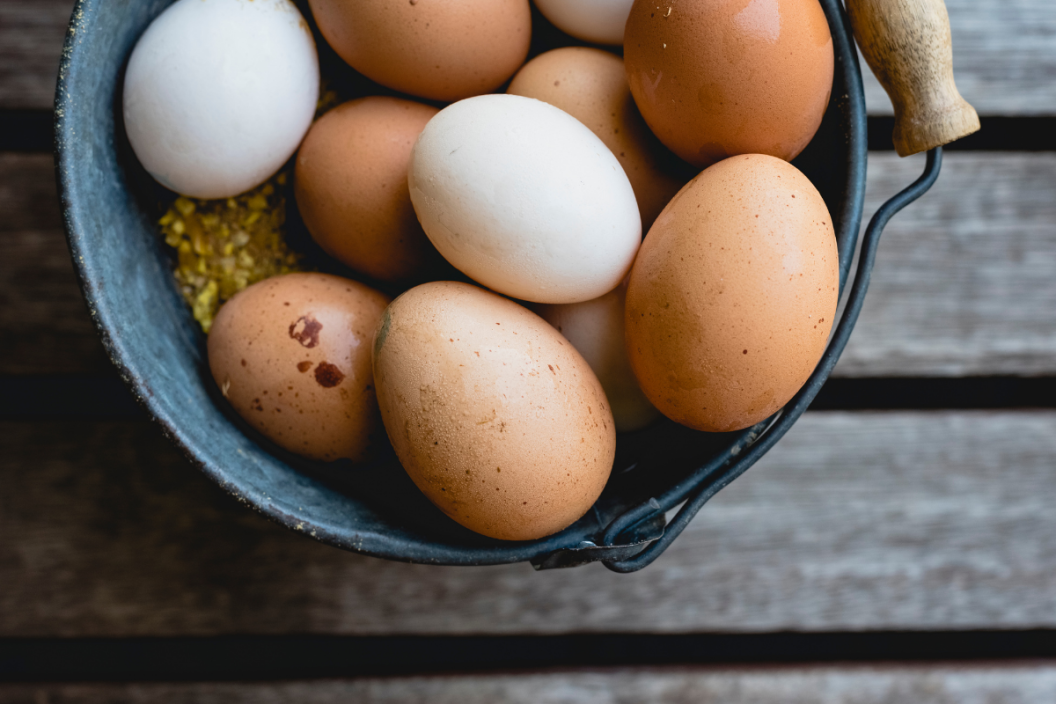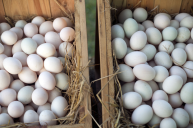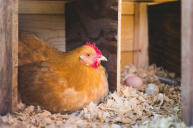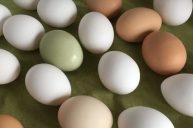Ever wondered how do chickens lay eggs? We've got answers.
If you have just established your backyard flock, we know you will be anxiously awaiting your first egg. But how do chickens lay eggs? The amount of fresh eggs you will get and number of eggs you will get will depend on the breeds of chickens you picked up. Rhode Island Reds are famous for laying lots of brown eggs, as are White Leghorn chickens. Other great laying hens are Plymouth Barred Rocks and Blue Andalusians. A mixed flock can result in an excellent hen house as well.
Another factor in laying process is how old a chicken is and how much light they receive during the day, which can always be supplemented with artificial light. You will receive fewer eggs from your hens during the winter, since there is far less light.
One of the most common questions about keeping backyard chickens is, "Do you need a rooster to get eggs from chickens?" The answer? No, your female chickens are perfectly capable of laying unfertilized eggs without a rooster. However, you do need a rooster if you want baby chicks to hatch from fertilized eggs.
Each egg takes 24-26 hours to form, which is broken down into four main parts below. In addition to how the egg forms, we'll also talk about light, age, calcium, and a popular misconception about finding a chick in an egg. So, let's get to the egg-laying questions!
How Do Chickens Lay Eggs?
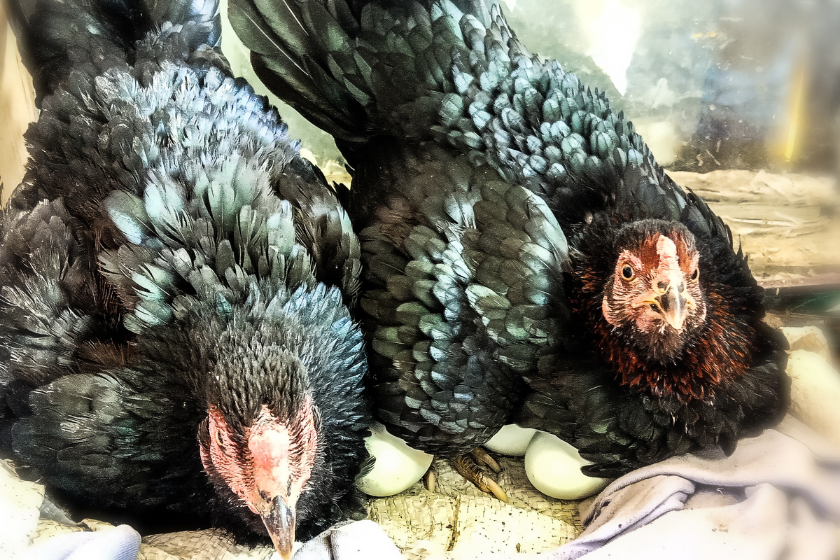
Step One: The Yolk Releases (15 minutes)
Within the developing ovary of each hen are the thousands of potential eggs. Each of these potential eggs is an ovum (or ova if you want to refer to all of them at once).
At any rate, when your pullet gets towards laying age, at 18-20 weeks of age, a few of the ova within a hen's ovary begin to mature into what we recognize as an egg yolk. Each ovum (or yolk) is contained within its own follicle. When a yolk is ready to move to the next stage, it releases from its follicle and travels out of the ovary and down the reproductive tract, also known as the oviduct.
Weird fact: Hens have only one functioning ovary, but they are born with two ovaries. At hatch, one ovary continues to develop in the hen's body, and one simply stops. Why? It is common in birds to have one ovary. This is a sort of streamlining that is likely to help with flight (less bulk and less weight).
Step Two: The White Forms (four-plus hours)
The yolk leaves the ovary and enters what we call the oviduct by way of the infundibulum, or entrance to the oviduct. This is where the egg would be fertilized if you did have a rooster. You know that tiny whitish spot you see on every egg yolk? That's a single female cell called a blastodisc. If it is fertilized by your rooster's sperm, cell division and embryo development begins and turns the blastodisc into what we call a blastoderm.
No rooster? No worries. Regardless of whether it is fertilized or not, the yolk (now known as a blastodisc or blastoderm) travels down through the magnum and the isthmus sections of the oviduct. This is where most of the albumen (known as egg white) forms around the yolk, and a thin outer shell membrane holds everything loosely together. Chalazae anchor the yolk roughly in the middle of the egg. At this point, the egg looks more like an egg, but we're still missing the outer shell.
Step Three: The Eggshell (21-plus hours)
The egg formation process continues as the egg gains its shell in the uterus via a shell gland. The shell takes about 20 hours to form and perhaps another hour for the color, or pigment, to be applied to the outer eggshell. This is where the eggshell gets its color, whether blue, white, brown, or green. Finally, the outermost eggshell layer forms a protective anti-microbial layer on the shell.
Step Four: The Nest Box
Your hens lay eggs through their cloaca, or what we call the vent. While eggs exit through the same vent used for everything a chicken excretes, the tissue of the uterus extends with the egg (a sort of inside-out trick) until the egg is entirely out of the vent. This little trick along with the bloom layer applied to the shell keeps the egg clean.
About half an hour after a hen lays, the process begins all over again. You don't need one nest box per hen, but you should have, at a minimum, at least one nest box for every four hens.
Egg Laying FAQs
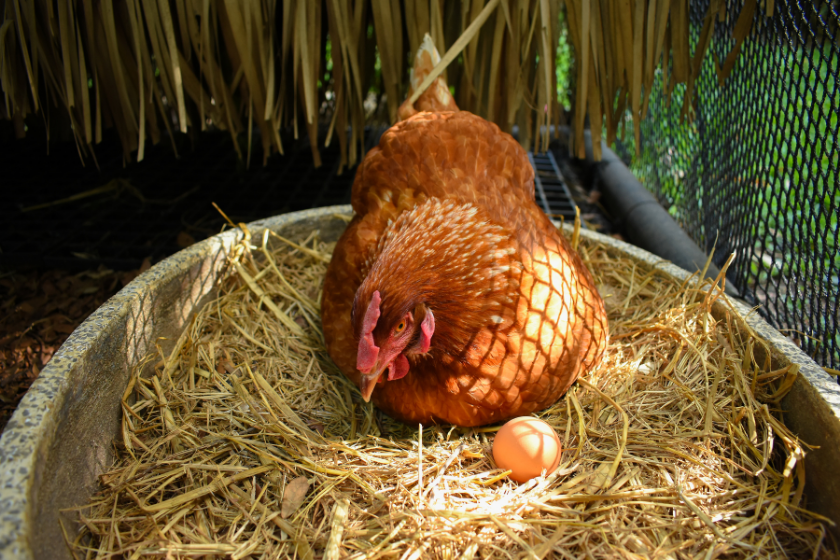
How Does Light Change Egg Laying?
Most hens lay more eggs in the spring and summer, and taper production during the fall and winter under natural light conditions. Hens need long days to lay eggs. We give our hens a break during the winter. We don't recommend adding a light to the coop to extend egg production and laying period. If you do wish to add a light, artificial light it should be on a timer and go on in the early morning hours when it's still dark.
How Does Age Change Egg Laying?
Many hens continue to lay past five years of age. If your hens start laying fewer eggs and they are only a few years old, it is more likely that it is either a molt or the season, not their age. Raising chickens is not entirely about egg-laying. Do you know how to keep your older chickens from getting creaky and cranky?
What Do Calcium Supplements Do?
Chicken eggs take a lot of calcium to produce. Chickens with a nutritional deficiency may not lay properly or as much, and you may see a difference in shell quality. If you collect eggs with thinner eggshells it may be that as your hen's calcium stores have dropped. Calcium leaches from their bones and other (now depleted) bodily stores. You need to supplement their diet better with free-choice crushed oyster shells or some other calcium source. Layer feed will help your chickens maintain nutrients and ensure that they are laying more often.
Is There a Chick in My Egg?
The only way you would ever crack open an egg and find a chick is if you 1) have a rooster and 2) you don't gather eggs every day (or every other day). You are never, ever, going to crack open a freshly laid egg and find a baby chick.
Even if you have a rooster, it takes three weeks for a chick to hatch from an egg with a warm broody hen on her nest or in an egg incubator. If you are gathering eggs each day, there is no time for any sort of egg development.
Now go out and impress your friends with your newfound chicken laying knowledge!
What's your favorite egg-laying misconception? Tell us on our Wide Open Pets Facebook page!
This article was originally published September 21, 2021.
